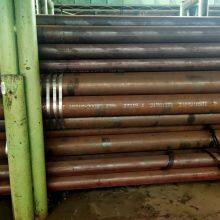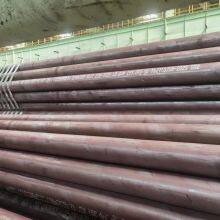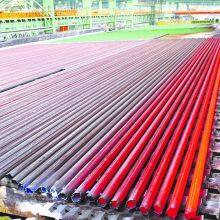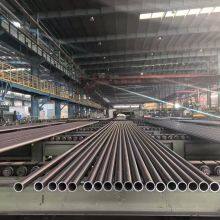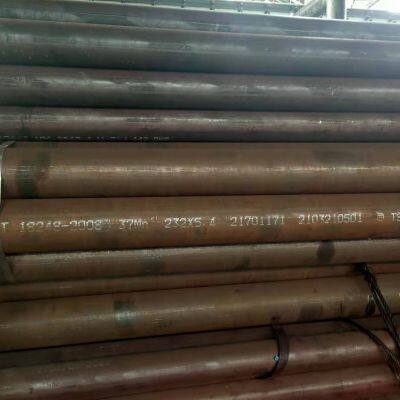GB/T18248-2008,GIS G3429,EN10297-1 34CrMo4 37Mn Seamless Steel Pipes for Gas Cylinders
34CrMo4 37Mn seamless steel pipes for gas cylinders
Seamless steel tubes for gas cylinders are seamless steel tubes suitable for manufacturing gas cylinder and accumulator shells.
Standard No: GB/T18248-2008,GIS G3429,EN10297-1
This standard specifies the dimensions, shape, weight, technical requirements, test methods, inspection rules, packaging, marking and quality certificate of seamless steel tubes for gas cylinders and accumulator shells.
This standard is applicable to seamless steel pipes used for manufacturing gas cylinders and accumulator housings.
Seamless steel tubes for gas cylinders :GB18248-2000(Seamless steel tubes for gas cylinders), mainly used for manufacturing various gas and hydraulic gas cylinders. Its representative materials include 37Mn,30CrMo,4130X,4140,35CrMo,34CrMo4 etc.
Steel seamless gas cylinders, with a working pressure generally ranging from 12.25 to 29.40MPa, are mobile gas cylinders that can be refilled repeatedly, used for holding permanent gases or high-pressure liquefied gases, etc.
There are generally two methods for manufacturing high-pressure gas cylinders: one is to use seamless steel pipes as blanks and form them by hot spinning with the edges and bottoms sealed (referred to as the M method); The second method is to form square steel billets through stamping, stretching and finishing (referred to as the E method). Up to now, both methods coexist, each with its own strengths. Manufacturing high-pressure gas cylinders with seamless steel pipes has become one of the main methods for producing high-pressure gas cylinders due to its features such as pure steel quality, dense structure, high precision in outer diameter and wall thickness, good surface quality, wide size range, large capacity of the produced gas cylinders, high operating pressure, light cylinder body, high productivity and low cost. The main discussion will focus on some technological issues related to the production of seamless steel pipes for high-pressure gas cylinders.
Technical requirements for seamless steel pipes used in high-pressure gas cylinders:
1 Steel:
The steel used for high-pressure gas cylinders is made of unaged killed steel, which is generally smelted in alkaline open hearth furnaces, electric furnaces, and oxygen-blowing alkaline converters. Some steel grades also need to undergo electroslag remelting or vacuum smelting. The main steel grades are high-quality manganese steel, chromium-molybdenum steel or other alloy steel, while high-quality carbon steel is rarely used nowadays. Demand for chemicals is: carbon manganese steel C or less 0.40% S 0.030%, or less P 0.035% or less, S + P 0.060% or less; Chromium-molybdenum steel and other alloy steels: C≤0.40%,S≤0.035%,P≤0.030%,S+ P≤ 0.055%; Corresponding regulations have also been made for other main components. The chemical composition requirements for alloy steel used in special ultra-high strength light gas cylinders are as follows :S≤0.010%,P≤0.015%,S+P≤0.020%. There are strict requirements for non-metallic inclusions and low-magnification structures in the steel. The non-metallic inclusions are :(A+C) class ≤3.0 grade,B class ≤3.0 grade, sum ≤5.5 grade. Defects such as white spots, residual shrinkage cavities, delamination and slag inclusion are not allowed in low-magnification tissues.
2. Mechanical Properties:
Gas cylinders are high-pressure vessels. To ensure safe use, in addition to having corresponding high tensile strength and yield strength, they are also required to have high elongation and impact toughness. The ambient temperature for the general use of gas cylinders in regions is -20 to 60℃, and in cold regions, it is -40 to 60℃. The former generally uses carbon-manganese steel cylinders that have undergone normalizing or normalizing + tempering treatment, while the latter usually adopts chromium-molybdenum steel cylinders that have undergone quenching and tempering treatment or other alloy steel cylinders. According to the provisions of GB5099-94 standard, after heat treatment, the two types of steel need to undergo V-shaped low-temperature impact tests at -20℃ and -50℃ respectively. Its impact toughness, yield-to-tensile strength ratio and elongation should reach the corresponding specified values. The inspection results of the samples of seamless steel pipes used as billets after heat treatment should also meet the requirements of this specified value.
3. Process performance and metallographic inspection:
According to the requirements of the gas cylinder manufacturer, the seamless steel pipe samples need to undergo flattening or cold bending tests. The flattening test shall be carried out in accordance with the GB13440 standard.
For steel pipe samples that have undergone normalizing or normalizing + tempering treatment, the grain size (100 times) should be ≥ grade 6, the banded structure ≤ grade 3.0, and the Widmanstatten structure ≤ grade 2.0. The microstructure of the steel pipe sample after quenching and tempering treatment should be tempered sorbite. In addition, there are also corresponding requirements for the depth of the decarburization layer of the pipe body.
4. Dimensional accuracy:
The wall thickness of gas cylinder bodies is designed based on the minimum wall thickness internationally. For instance, the calculation of the minimum wall thickness in international standards such as ISO 4705, the US DOT, the German DIN4664, and the Japanese JISB 8230 and 8241 is all based on the yield strength. The calculation of the minimum wall thickness in China's GB5099 standard (refer to the calculation formula) has also been changed from the previous calculation based on tensile strength or yield strength to the calculation based solely on yield strength in reference to the ISO4705 standard.
After the minimum wall thickness is given, the main task for seamless steel pipes used in high-pressure gas cylinders is to ensure that the wall thickness deviation is not less than the minimum wall thickness, so as to meet the wall thickness requirements for the safety of the gas cylinder body. Under the premise of ensuring the minimum wall thickness, the thinner the wall and the higher the wall thickness accuracy, the lighter the gas cylinder weight and the larger the volume, that is, the smaller the weight-to-volume ratio, and the better the quality of the gas cylinder. According to the requirements of GB5099 standard, the wall thickness deviation of seamless steel pipes supplied by the steel pipe factory for manufacturing medium and small gas cylinder bodies is generally + 15/ -10%.
According to the requirements of GB5099 standard, the deviation of the outer diameter of medium and small gas cylinders, that is, the deviation of the outer diameter of the supplied seamless steel pipes, is generally D ±1.25%. The deviation of the wall thickness and outer diameter of large-volume gas cylinder tubes shall be determined by mutual agreement between the supplier and the buyer based on specific specifications.
5. Surface quality of the pipe body and flaw detection:
As the surface quality of gas cylinders directly affects the safety and aesthetics of their use, there should be no defects such as cracks, folds, scabs, delamination, rolling folds, or pockmarks on the inner and outer surfaces of the steel pipes. If there are such defects, they must be removed thoroughly, and the wall thickness after removal must be greater than the negative deviation of the wall thickness or the minimum wall thickness value required by the design.
To further ensure the quality of the entire cross-section of the pipe body, seamless steel pipes before leaving the factory shall undergo ultrasonic flaw detection inspection in accordance with the GB 5777 standard. The requirements shall be implemented in accordance with the GB5099 standard and the GB 8163 standard.
The production process of seamless steel pipes for high-pressure gas cylinders:
The main methods for manufacturing seamless steel pipes for high-pressure gas cylinders at home and abroad are:
Large pipe jacking - manufacturing pipe billets for gas cylinders by punching and jacking steel ingots (billets). Steel pipe factories, heavy machinery factories, etc. often adopt this method. It is suitable for manufacturing large-diameter, thick-walled and large-capacity high-pressure gas cylinders and containers.
Pipe rolling - After heating and piercing steel ingots (or round rolled billets, continuous casting billets), they are hot-rolled into pipe billets by periodic pipe rolling mills, automatic pipe rolling mills, continuous pipe rolling mills, etc. Then, they are hot-sized, straightened and finished into seamless steel pipes. This is one of the most important methods adopted for the production of large quantities of gas cylinder tubes.
In order to expand the range of varieties and specifications, the pipe rolling plant can also further process the pipe billets that have passed hot rolling through cold rolling (drawing) machines to reduce diameter and wall size, and produce pipe billets for manufacturing medium and small volume gas cylinders. The tube billets that have passed hot rolling can also be processed into tube billets for manufacturing large-volume gas cylinders by expanding the diameter and reducing the wall through a hot expansion machine.
The development of special seamless steel pipes for high-pressure gas cylinders and the like, from the evolution of standards, technical requirements, to product quality and production processes, is all carried out in line with the demands of high-pressure containers such as high-pressure gas cylinders and is gradually aligning with international standards.
With the upgrading and improvement of smelting, pipe rolling and large pipe jacking equipment, the continuous modernization of process technology and the enhancement of management level, China has formed the capacity to produce seamless steel pipes for various high-pressure gas cylinders and other high-pressure vessels, which can basically meet the production needs of high-pressure vessel manufacturing departments. 232mm*5.4mm and 356mm*7.7mm gas cylinder tubes are widely used.

Send Inquiry to This Supplier
You May Also Like
-
Baotou Steel NACE MR0175 ISO15156 Sour Service X52 PSL2 X60QS Seamless Steel PipeNegotiableMOQ: 30 Metric Tons
-
Baotou Steel GB/T9948 10# 20# 15CrMo Petroleum Cracking Steel PipesNegotiableMOQ: 30 Metric Tons
-
Baotou Steel GB/T6479 20# Q345B Q345C Q345D Q345E High Pressure Fertilizer Steel PipeNegotiableMOQ: 30 Metric Tons
-
Baotou Steel GB/T17396 30CrMnSiA 27SiMn Hydraulic Prop Steel PipeNegotiableMOQ: 30 Metric Tons
-
Baotou Steel GB/T9808 DZ50 R780 DZ40 Geological Steel PipeNegotiableMOQ: 30 Metric Tons
-
Baotou Steel API 5L Seamless Steel PipeNegotiableMOQ: 30 Metric Tons
-
Baotou Steel HG20553 (Ia) GB/T9948 15CrMo 10# 20# Seamless Steel Pipes for Chemical IndustryNegotiableMOQ: 30 Metric Tons
-
Baotou Steel Seamless PipesNegotiableMOQ: 30 Metric Tons
-
Baotou Steel Sour Service X60 X52 Seamless PipesNegotiableMOQ: 30 Metric Tons
-
Baotou Steel X60 PSL2 Seamless Steel Pipes for Oil and Gas PipelineNegotiableMOQ: 30 Metric Tons


